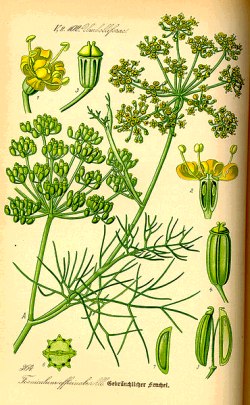General History of Fennel
(Fæniculum officinale, All.)

Fennel history dates back to Pliny (AD 23-79), the Roman author of The Naturalis Historie. He believed that serpents ate and rubbed against fennel because it was able to improve their eyesight after shedding their skins. Following that observation, Pliny believed fennel was so powerful that he used the aromatic herb to treat 22 different ailments.
In our fennel history timeline, we come to the 1300s. We know that fennel was a staple in the household of King Edward I of England. His wardrobe account books from 1281 listed a purchase of 8 1/2 pounds of fennel seed – a month’s supply. Why so much? Fennel seed was used as a condiment and an appetite suppressant. On Church mandated ‘Fastying dayes’, the faithful used fennel to get through the day, a tradition brought to the United States by the Puritans. They would bring handkerchiefs with fennel seed to nibble on during long services to stave off hunger; which led to fennel seeds often being referred to as ‘meetin’ seeds’.
During medieval times, evil spirits were thought to roam freely as the sun turned southwards. Fennel, when hung over doorways, was thought to protect those within from the spirits. Fennel seeds inserted into keyholes were thought to protect a dwelling from ghosts on any night but particularly Midsummer’s Eve.
Fennel History – Medicinal Uses
Hippocrates (yes, he’s the fellow the physician’s oath is named for) suggested fennel could aid wet nurses to increase their milk supply.
One physician from the thirteenth century noted in the Book of Physicians of Myddvai “he who sees fennel and gathers it not, is not a man but a devil.” A contrary opinion led to the traditional saying that “sowing fennel is sowing sorrow” that predicted disaster to anyone giving away fennel. In the mid 15th Century, it was said of fennel…”The juice of fenell put into a mans eares, killeth the wormes therein.”
When steeped into a tea it was believed that fennel was also a treatment for losing weight. The Greeks called it Marathron which is derived from a word meaning to grow thin.
History of Fennel as an Antidote.
Fennel is often used with preparing fish. In the mid 1600s, one noted physician, Nicholas Culpepper, approved of it’s use stating, “it consumes that phlegmatic humour, which fish most plentifully afford and annoy the body with, though few that use it know wherefore they do it; I suppose the reason for its benefit this way is because it is an herb of Mercury and under Virgo, and therefore bears antipathy to Pisces.”
Fennel was used as an antidote to poisons by the Romans, Chinese, and Hindus. Culpepper also believed fennel to be an effective antidote for poisonous mushrooms and snake bites. A plaster of fennel roots was a traditional treatment for the bites of mad dogs.
In a publication from the late 1880s, Alphonse Karr, for whom the dahlia was named, tried to put claims of fennel’s healing properties to rest with his announcement, “At the end of three or four hundred years, it began to be perceived that it (fennel) had never cured anyone.”
Additional Fennel Information.
Our Herb Garden also has guides on Growing Fennel and Fennel Companion Planting.